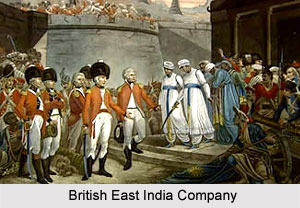 European traders began to sail to the East even before the Mughal dynasty was established. As a matter of fact they were attracted by the legendary wealth of `the Indies`. The Portuguese led the way in 1498. Their hundred years of monopoly over the Arabian Sea trade was challenged in the beginning of the seventeenth century. The challenge was drawn by the Dutch and the English. The former established outposts in India, but their interest always lay down further east. The Mughal empire was still strong, and the `Spice Islands` i.e. Indonesia was more ripe for exploitation.
European traders began to sail to the East even before the Mughal dynasty was established. As a matter of fact they were attracted by the legendary wealth of `the Indies`. The Portuguese led the way in 1498. Their hundred years of monopoly over the Arabian Sea trade was challenged in the beginning of the seventeenth century. The challenge was drawn by the Dutch and the English. The former established outposts in India, but their interest always lay down further east. The Mughal empire was still strong, and the `Spice Islands` i.e. Indonesia was more ripe for exploitation.
The English, driven out from the Moluccas by their rivals, had to settle for trade with India. No one could have anticipated when their first `factory` or trading post was established at Surat in 1612, that in little more than two hundred years the British East India Company would be the master of a domain more than ten times the size of the United Kingdom. No one could have imagined that the British nation, rich with the plundered wealth of its empire, would have become the most powerful country in the world by then. And they would eventually leave India as one of the poorest.
At first the trade of the East India Company was of mutual benefit to Britain and to the Mughal Empire. Great amounts of silver were dispatched from London to pay for Indian exports. The Mughal treasuries were filled, and the weavers and craftsmen of the realm kept busy.
In these early days the British did fighting with the other Europeans. In the first half of the seventeenth century they inflicted a series of defeats on the Portuguese. They were equally successful against the Dutch, who by the end of the eighteenth century were thrown out from the subcontinent. The British Company grew slowly but steadily. In the seventeenth century trading centres were set up in Madras, Bombay and Calcutta. These three ports soon gave their names to the three separate `presidencies` into which the Company organized its expanding trade. Later these presidencies became the great provinces of British India, but for the moment their territories hardly extended beyond the factory walls.
It was at this time that the British first began to feel the lust for empire. The Company that originally wanted only by the name of `a quiet trade` now aspired to something else. They thought as to `lay the foundation of a large, well-grounded, sure English dominion for all time to come`. This ambition was premature. In 1686 the Company declared war on the emperor and was soundly defeated the English obtained pardon only after apologizing abjectly for the ill crimes they may have done. The foreigners were still too weak and the Indians were too strong. But the balance of power would soon be dramatically altered.
The first half of the eighteenth century was the period of the great decline of the Mughal Empire. During these troubled times the British Company began to enlist Indian soldiers to protect their trade. During this mission the French also set up a rival company in 1664. When Indian nobles began asserting their independence from Delhi, they found it convenient to take the help of these foreign armies, which were well organized and equipped with advanced implements of war. The English and French were glad to oblige, for, if the side they backed emerged victorious, they would be sure to gain advantages.
At this time the two European powers were engaged in a worldwide struggle for political and commercial supremacy. Between 1740 and 1760 European wars in which France and England were opponents brought them into conflict in India as well. When the lighting and diplomatic maneuvering were over, the French had virtually been driven from the country. In the process, the British gained a territorial foothold in Bengal from which they would stride victoriously across India.



















